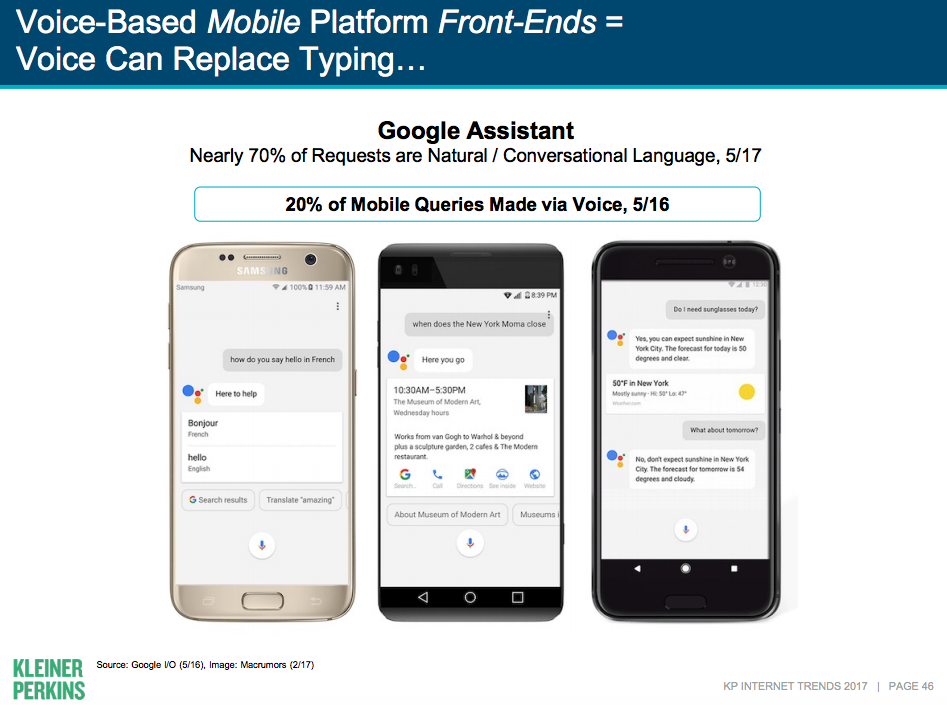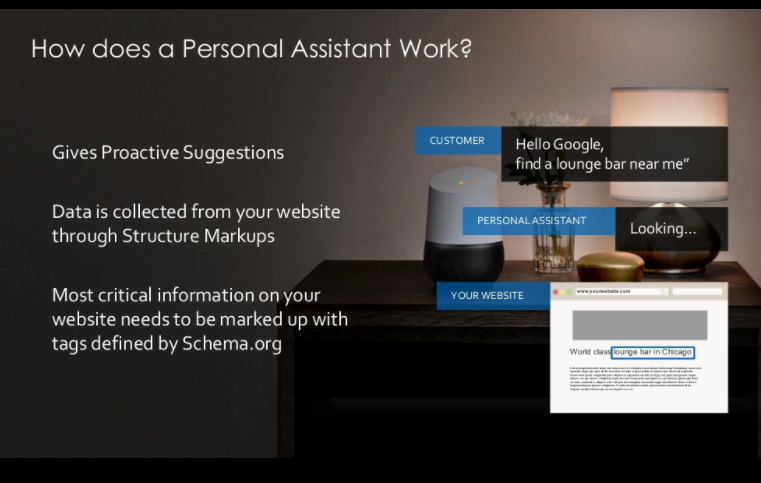Is Your SEO Strategy Optimized for Voice Technology?
Is Your SEO Strategy Optimized for Voice Technology?
Mike Mangi | Director of Digital Strategy
November 15, 2017
Voice Technology Is Changing the Way We Search
From short keywords, to boolean operators, to mobile first, the way people search the internet for information is constantly evolving. The rise of voice search on personal digital assistants like Siri, Alexa, Cortana and Google Home means an increase in longer phrase, spoken queries. This technology is able to process natural language. And that means that users no longer have to search with simple keywords. Instead they can ask search engines questions the same way they would other humans.
Voice search usage continues to increase as technology accuracy approaches human levels of understanding. Mary Meeker’s 2017 internet trend report highlights that Google’s advances in natural language processing have lead to a 95% voice word accuracy rate.

What does this shift to voice search mean to digital marketers and content creators?
Digital marketers and content creators need to optimize their content, and publishing platforms for voice search. That includes researching users, developing a content strategy, adjusting content language and tone, and continuous testing and iteration. Here is a guide to help you hone your Search Engine Optimization (SEO) strategy to improve the findability of your content for voice search queries.
Study Your Users’ Search Intent
Your target audiences will not find your content if it is not optimized to answer the questions they are actually asking search engines. Search Intent Modeling, also known as Consumer Intent Modeling, is an analytics-based approach to matching an organization's target audiences' search intent (what a target audience wants to find) with their digital content strategy (the actual content they provide).
Natural language voice searches are making it easier to decode user intent.
There are three basic types of searches:
- Informational: users searching with the intent to learn more about a topic, product, or service
- Navigational: users searching with the intent to find a specific website or application
- Transactional: users searching with the intent to purchase a product or service
And the way users ask questions can help to understand how they are progressing from informational search to transactional.

Research your target audiences to better understand their needs and the types of searches they are performing. A combination of surveys, interviews, and analytics will help determine their goals and pain points. What are they looking for and why are they looking for it? What words and phrases do they use in their searches? How successful are they are finding what they are looking for? Use the research to develop audience personas and user journey maps to help answer these questions.
Develop a Voice-Focused Content Strategy
Once you understand your users’ search intent, develop a content strategy that directly answers the questions they are asking.
Use Conversational Questions and Phrases
Almost 70% of voice searches with Google Assistant use conversational language. Conversational language means users ask complete questions. Those voice search questions can be turned into page titles, section headers, and Frequently Asked Questions pages.

Localize Your Search
Be sure to consider opportunities for localized search. Voice searchers are often looking for businesses and services “near me” or “by me.” Be sure to include your location information in your content strategy to take advantage of proximity opportunities.
Cut the Internal Jargon
Internal jargon is a findability killer. When you use specialized industry lingo, or internal acronyms, the audiences you want to target, who don’t already know your code words and products’ names, will be funnelled to your competitors who are using plain language and clear descriptors. Overuse of internal and corporate jargon often prevents target audiences (who search with their own set of keywords) from finding relevant content. Unbounce created a Chrome plugin to help you detect jargon in your content.
Incorporate Long Tail Keywords and Phrases
Voice searches are longer and more specific than text based searches. The more closely you’re able to tailor your content to the complete voice phrases your target audiences are using, the more you’ll benefit from the higher conversion rates that accompany qualified click throughs. There is less competition for specific search terms and phrases, than for broad keywords, which will also help boost your results page positioning.
Apply Schema Markup to Your Content
Schema.org provides structured data markup schemas to help search engines more deeply understand your content. These schemas provide a way to call out people, places, events, and other information critical to providing quick responses in voice search.

The set of tags that allow you to do this are called microdata. Here is an example of medical microdata used to tag the symptoms that ibuprofen can help remedy:
<div itemscope itemtype="http://schema.org/Drug">
<span itemprop="name">Ibuprofen</span> is a non-steroidal anti-inflammatory medication, indicated for temporary relief of minor aches and pains due to
<span itemprop="indication" itemscope itemtype="http://schema.org/TreatmentIndication">
<span itemprop="name">headache</span>
</span>,
<span itemprop="indication" itemscope itemtype="http://schema.org/TreatmentIndication">
<span itemprop="name">toothache</span>
</span>, ...
</div>
Incorporate microdata tagging into your content strategy, and use Google’s Structured Data Markup Helper to recommend the right microdata tags for your content, and the Google’s Structured Data Testing Tool to make sure you have tagged your content correctly.
Tools and Testing
There are a large number of tools that can help you determine the best keywords and phrases to incorporate into your content, and test and optimize your content for search engines. Here are some of the best:
Answer the Public
A great tool for digging into voice search intent. Answer The Public returns a visualization of all of the questions users ask about a keyword or topic.

Moz Keyword Explorer
Enter a keyword, domain, or page URL to get suggestions on keywords, and an analysis of the monthly volume for those keywords, and how competitive they are. Moz has a whole suite of other great SEO tools as well.
Serpstat
SERP is an acronym for Search Engine Results Page. Like Moz, Serpstat provides a good deal of data and reporting on keyword trends and ranking. The competitors graphs show the sites with which you’re directly competing.
Google’s Search Terms Report
If you use Google AdWords to boost traffic, the Search Terms Report will give you insight into the search terms users ask Google to get to you, as well as, negative keywords to avoid. Google’s Keyword Planner will also help you understand relevancy.
DistilledODN
This tool uses a delivery network to provide a way to A/B test your keywords. Giving you great insight into which terms are going to provide the most improvement in your search engine optimization.
Optimizing your content for voice search is critical to a successful SEO strategy. Contact Phase2 if you need help getting started. And read more about how voice technology and machine learning are changing the digital landscape here.
